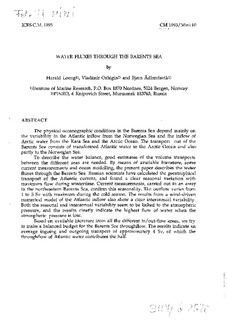Water fluxes through the Barents Sea
Original version
This report is not to be cited without prior reference to the authorsAbstract
The physical oceanographic conditions in the Barents Sea depend mainly on
the variability in the Atlantic inflow from the Norwegian Sea and the inflow of
Arctic water from the Kara Sea and the Arctic Ocean. The transport out of the
Barents Sea consists of transformed Atlantic water to the Arctic Ocean and also
partly to the Norwegian Sea.
To describe the water balance, good estimates of the volume transports
between the different seas are needed. By means of available literature, some
current measurements and ocean modelling, the present paper describes the water
fluxes through the Barents Sea. Russian scientists have calculated the geostrophical
transport of the Atlantic current, and found a clear seasonal variation with
maximum flow during wintertime. Current measurements, carried out in an array
in the northeastern Barents Sea, confirm this seasonality. The outflow varies from
1 to 3 Sv with maximum during the cold season. The results from a wind-driven
numerical model of the Atlantic inflow also show a clear interannual variability.
Both the seasonal and interannual variability seem to be linked to the atmospheric
pressure, and the results clearly indicate the highest flow of water when the
atmospheric pressure is low.
Based on available literature from all the different in/ out-flow areas, we try
to make a balanced budget for the Barents Sea throughflow. The results indicate an
average ingoing and outgoing transport of approximately 4 Sv, of which the
throughflow of Atlantic water contributes the half.
